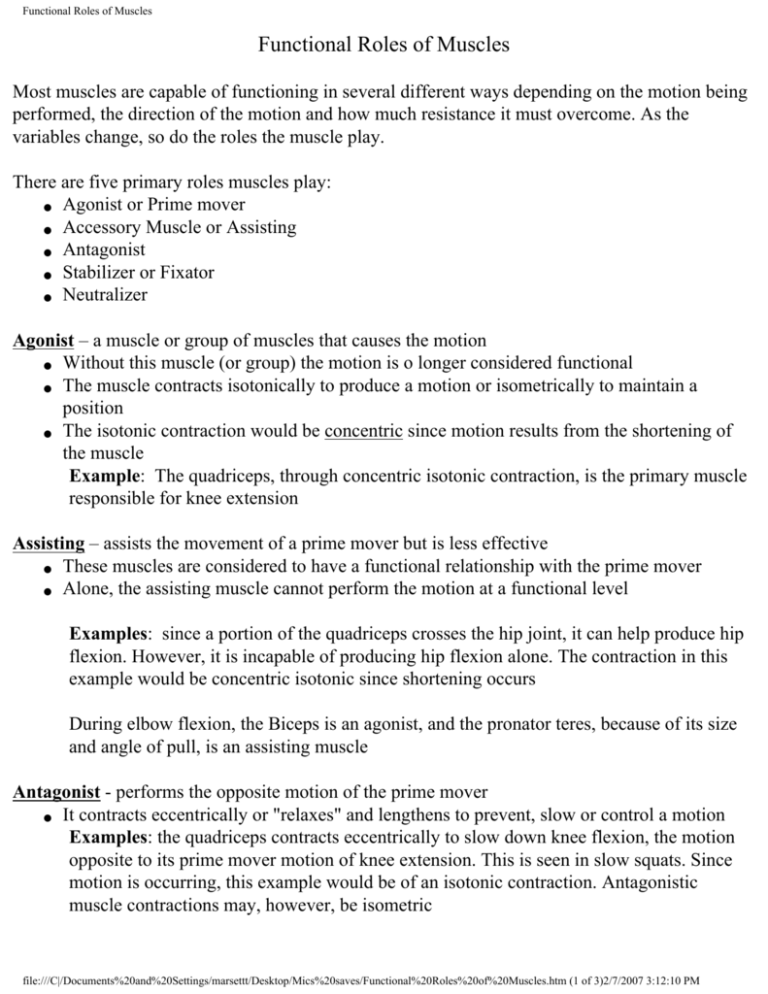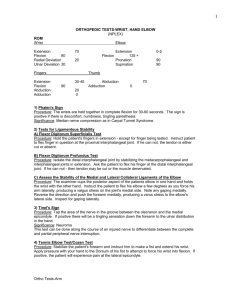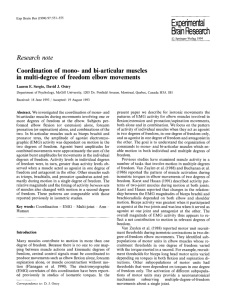Functional Roles of Muscles
advertisement

Functional Roles of Muscles Functional Roles of Muscles Most muscles are capable of functioning in several different ways depending on the motion being performed, the direction of the motion and how much resistance it must overcome. As the variables change, so do the roles the muscle play. There are five primary roles muscles play: ● Agonist or Prime mover ● Accessory Muscle or Assisting ● Antagonist ● Stabilizer or Fixator ● Neutralizer Agonist – a muscle or group of muscles that causes the motion ● Without this muscle (or group) the motion is o longer considered functional ● The muscle contracts isotonically to produce a motion or isometrically to maintain a position ● The isotonic contraction would be concentric since motion results from the shortening of the muscle Example: The quadriceps, through concentric isotonic contraction, is the primary muscle responsible for knee extension Assisting – assists the movement of a prime mover but is less effective ● These muscles are considered to have a functional relationship with the prime mover ● Alone, the assisting muscle cannot perform the motion at a functional level Examples: since a portion of the quadriceps crosses the hip joint, it can help produce hip flexion. However, it is incapable of producing hip flexion alone. The contraction in this example would be concentric isotonic since shortening occurs During elbow flexion, the Biceps is an agonist, and the pronator teres, because of its size and angle of pull, is an assisting muscle Antagonist - performs the opposite motion of the prime mover ● It contracts eccentrically or "relaxes" and lengthens to prevent, slow or control a motion Examples: the quadriceps contracts eccentrically to slow down knee flexion, the motion opposite to its prime mover motion of knee extension. This is seen in slow squats. Since motion is occurring, this example would be of an isotonic contraction. Antagonistic muscle contractions may, however, be isometric file:///C|/Documents%20and%20Settings/marsettt/Desktop/Mics%20saves/Functional%20Roles%20of%20Muscles.htm (1 of 3)2/7/2007 3:12:10 PM Functional Roles of Muscles With elbow extension, the triceps would be the agonist and the biceps would be the antagonist. With elbow flexion, the biceps would be the agonist and the triceps would be the antagonist Stabilizer - the muscle may contract to hold a body part immobile while another body part is moving. The sustained stabilizing contraction is frequently isometric. In most normal activities, proximal joints are stabilized by muscle contractions during movement of more distal joints proximal stabilization. For an isolated movement at one joint to occur, the muscles that control the joints proximal to that joint must stabilize the proximal joints so that no motion occurs there. The antagonists for each motion at the proximal joint co-contract or contract against each other to prevent motion. Example: the quadriceps may stabilize the knee in an extended position of permit plantar flexion of the ankle as when the individual rises to tip-toe in erect position To perform isolated elbow flexion the proximal shoulder joint must be stabilized by flexors/extensors, abductors/adductors and internal/external rotators. Neutralizer - prevents unwanted motions a muscle can perform so a specific motion can occur. Mostly dependant on the angle of pull. Examples: the biceps can flex the elbow and supinate the forearm. If only elbow flexion is wanted, the supination component must be ruled out. Therefore, the pronator teres, which pronates the forearm, would contract to counteract the supination component of the biceps, and only elbow flexion would occur. Neutralizers act to cancel out an unwanted movement With wrist ulnar deviation the flexor carpi ulnaris will cause lexion and lunar deviation of the wrist. The extensor carpi ulnaris will cause extension and ulnar deviation. If ulnar deviation is desired, these muscles would contract doing two things: they would neutralize each other's flexion/extension component, and they would act as agonists in wrist ulnar deviation Stabilizers and Neutralizers both use co-contraction to prevent motion and have an antagonistic relationship. Stabilizers are associated with joints; Neutralizers are associated with muscle. Relationships Between Muscles Antagonist - muscles which work against each other have an antagonistic relationship Agonist - prime mover or assisting muscles for a specific function have agonistic relationship file:///C|/Documents%20and%20Settings/marsettt/Desktop/Mics%20saves/Functional%20Roles%20of%20Muscles.htm (2 of 3)2/7/2007 3:12:10 PM Functional Roles of Muscles Special Actions Reverse Function - the muscle concentrically contracts moving the origin to insertion ● The proximal lever moves toward the distal lever ● Reverse function is associated with heavy work Examples: the biceps usually pulls the forearm toward the humerus. During chin-ups the biceps is asked to perform the more difficult tasks of lifting the body's weight toward the forearm instead of weight toward the humerus Knee flexion during lowering the body into a chair. The femur moves toward the lower leg Forward bending of the trunk over the femur instead of SLR Push-ups Continued Action (for multijoint muscles only) The muscle first concentrically contracts to perform the motion at the most distal joint is crosses It may then continue to contract (shorten) and perform motions at more proximal joints through continued action Examples: the biceps first pulls on the radius (elbow flexion) then performs houlder flexion. If the triceps muscle neutralizes the elbow flexion, then the biceps will perform shoulder flexion Finger flexion occurs first, then wrist flexion The latissimus dorsi acts first to depress and retract the shoulder girdle, then continues to laterally flex the trunk The pectoralis major (middle fibers) first adducts and internally rotates the shoulder, then continues to protract the shoulder girdle file:///C|/Documents%20and%20Settings/marsettt/Desktop/Mics%20saves/Functional%20Roles%20of%20Muscles.htm (3 of 3)2/7/2007 3:12:10 PM









